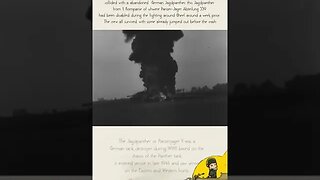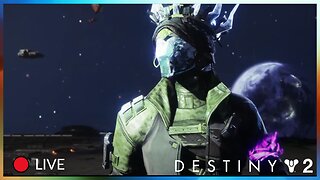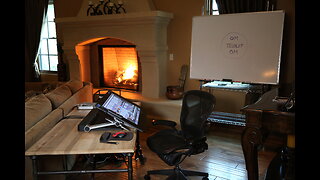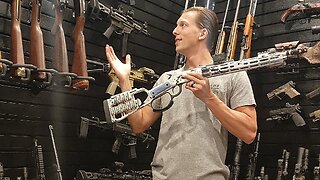Rare WW2 Tiger II "Königstiger" Panzerkampfwagen Tiger Ausf. B - Footage.
0:03 The new Tiger II and a Jagdtiger are presented to Hitler.
0:09 Dwight D. Eisenhower is shown several destroyed German vehicle like a StuG II and a overturned Tiger II that was pushed of the road during the Battle of Normandy.
You can see Eisenhower taken pictures of the vehicles for his personal album.
0:31 A destroyed Tiger II in Le Plessis-Grimoult, Normandy, filmed on the 10 August 1944.
1:11 Tiger II with the early turret being tested at the Haustenbeck training grounds.
5:58 The vehicles engine was eventually drowned and destroyed by the British.
6:11 Tiger 124 is seen in this newsreel together with another Tiger with turret number 112, today it's still stuck in that same crater and buried under a road
6:25 Propaganda film that was made at Camp Senne (near Paderborn) in September 1944.
The Tiger II was a German heavy tank of WWII. The tank was designated as Panzerkampfwagen Tiger Ausf. B, and the ordnance inventory designation was Sd.Kfz. 182. It was never called Königstiger during the war just like the Allied name King Tiger or Royal Tiger, King Tiger was the American name for the vehicle after a wrong translation after the war.
The Tiger II was the successor to the Tiger I, combining the latter's thick armour with the armour sloping used on the Panther medium tank.
Development of a heavy tank design had been initiated in 1937, the initial design contract was awarded to Henschel. Another design contract followed in 1939, and was given to Porsche.
The Henschel version used a conventional hull design with sloped armour resembling the layout of the Panther tank, Porsche hull designs included a rear-mounted turret, a mid-mounted engine and the same suspension as on the Elefant tank destroyer. Both prototypes would use the same turret design from Krupp and Porsche and Henschel never designed any turrets.
The early turret design was changed to the later one because the design was difficult to manufacture because of the curved bulge.
Henschel won the design contract, and all Tiger IIs were produced by the firm, but production was severely disrupted by Allied bombing raids. Only 492 units were produced one in 1943, 379 in 1944, and 112 in 1945. Full production ran from mid-1944 to the end of the war.
Early Tiger IIs proved unreliable, owing principally to leaking seals and gaskets, and an overburdened drive train originally intended for a lighter vehicle.
The First 45 Tiger tanks arrived on the Eastern Front with only eight that could be used because most of them were lost due to drive-train failures. The other 5 broke down before they could be used in combat, and were destroyed to prevent capture.
The introduction of modified seals, gaskets and drive train components, as well as improved driver training and sufficient maintenance improved the tank's mechanical reliability.
The first combat use of the Tiger II was by the s.H.Pz.Abt.503 during the Battle of Normandy, other Tigers saw action on the Eastern Front on 12 August 1944 with the s.H.Pz.Abt. 501.
Several Tigers were lost against T34-85 tanks close to Baranów Sandomierski and another 14 were lost between 11 and 14 August and three Tiger II tanks were captured by the Soviets, which allowed them to conduct tests at Kubinka and to evaluate its strengths and weaknesses.
During the Battle of the Bulge in December 1944, 150 Tiger IIs were present, nearly a third of total production and most were lost over the course of the offensive, were most of which were abandoned and destroyed by their own crews after mechanical breakdowns or for lack of fuel.
Even due the Tiger II was a mechanical nightmare, the heavy armour and powerful long-range gun gave the Tiger II an advantage against all opposing Western Allied and Soviet tanks attempting to engage it from head on, and no tank could actually go into a head to head combat scenario with the machine until the arrival of the few M26 Pershings in 1945 and the few M4A3E2 Sherman "Jumbos".
Reports estimated that the Tiger II's frontal aspect was impervious to the Soviet 122 mm D-25T, the largest caliber tank gun of the war. However, Soviet testing contradicted this as they found that the frontal glacis could be destroyed by firing 3–4 shots at the weld joints from the ranges of 500–600m, and in theory the QF 17-pounder gun, using armour-piercing discarding sabot shot was capable of penetrating the front of the Tiger II's turret and nose.
As a result of its thick frontal armour, flanking man-oeuvres were most often used against the Tiger II to attempt a shot at the thinner side and rear armour.
The armour of the Tiger II also proofed to be from a really poor quality and the plates exhibited deficiencies in quality compared to earlier German tanks such as the Tiger I and Panther.
and even when shells did not penetrate the armour, there was often a large amount of spalling from the inside of the plates, which damaged the transmission and rendered the tank inoperable.
-
 0:59
0:59
PANZER Insight
10 months agoJagdpanther Destroys Plane. #shorts 87
44 -
 2:45
2:45
Chicks in the Office
2 hours agoHolly Madison Talks Reconciliation with Kendra Wilkinson
5.25K7 -
 LIVE
LIVE
Di bear
3 hours agoFinal Season Mission, Pantheon | Destiny 2
871 watching -
 LIVE
LIVE
SquallRush
6 hours agoAthenian Rhapsody!
562 watching -
 1:47:01
1:47:01
Real Coffee With Scott Adams
4 hours agoEpisode 2492 CWSA 06/01/24
8.5K28 -
 LIVE
LIVE
LFA TV
4 hours ago| WHISTLE BLOWERS 6.01.24 12pm EST
622 watching -
 1:13:59
1:13:59
Tactical Advisor
3 hours agoVault Room Tour/Unboxing- Vault Room Live Stream
6.21K2 -
 1:11:28
1:11:28
The Squad
9 hours agoArsenal's Huge Summer🚨Olise to Man Utd DEAL✅ Osimhen to Arsenal or Chelsea☑️ UCL Final Preview
16.2K6 -
 56:23
56:23
Trumpet Daily
23 hours ago $1.10 earnedCohen Is Free to Lie and Steal, but Trump Is Guilty of Something - Trumpet Daily | May 31, 2024
15.8K25 -
 8:26
8:26
MichaelBisping
21 hours agoBISPING CHOKES OUT STEVE-O! | JACKASS STAR PUT TO SLEEP BY UFC CHAMP! *FULL VIDEO*
37.8K11